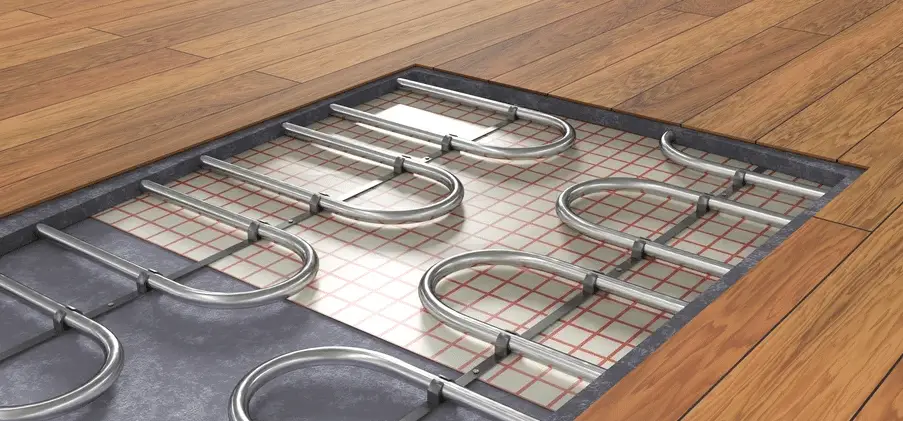Underfloor heating system is a type of central heating or cooling system that achieves thermal comfort by controlling and regulating indoor climate control. Underfloor heating is an excellent alternative for the conventional heating systems, and releases heat at the floor level. Underfloor system uses the natural convection to their advantage unlike ceiling-based heating systems which in turn promotes energy efficiency, thermal comfort and indoor air quality.
There are 2 main types of underfloor heating systems, electric underfloor heating system, also known as dry system, and hydronic underground heating system, also known as wet system. Hydronic heating systems have the floors embedded with resistance heaters or hot water piper making the floor itself release heat. Trench heaters are installed in the floor opening and covered with ventilation grilles. Architects user underfloor heating for avoiding component clash in the design.
How Does Underfloor Heating Save Energy
Heat delivered from below distributed the warm air by natural convection at zero energy cost. However, in case of ceiling-based heating systems, the warm air must be pushed down with the help of fans. This results in increased energy consumption as the fan power needs to establish an airflow that overcomes the natural convection, and additional heating is needed for compensating the inefficient air distribution.
Hydronic piping systems have a lower operating cost than electric resistance systems since heating the water with a heat pump or a boiler is less expensive than heating the floor directly with electric resistors. Electric radiant floors have easier installation, but the operating cost get higher over time.
Trench heaters are in direct contact with the indoor air, thus faster heating can be achieved with the help of fans. However, fans are optional and the heating system can operate independently with only natural convection. Fan assisted trench heaters coupled with Electronically Commutated motors (ECM) can offer up to 75% savings as compared with the single-speed fan motors.
How Does Underflow Heating Improve Comfort
In case of forced air systems, they require a high ventilation rate to overcome to natural convection. This in turn produces air turbulence and drafts, which may cause discomfort due to uneven distribution of heat. This also leads to forming of cold spots which further adds to the discomfort.
This can be eliminated with underflow heating, thus promoting a more comfortable indoor temperature during all seasons. At work places, a thermal comfort is known to boost productivity. Also, underfloor heating systems are silent as they don’t need fans for heat distribution. This creates a comfortable environment for the employees and occupants.
Radiant heating can also offer safety benefits when used outdoors. Ice and water cannot accumulate since the heat is released from the floor. This eliminates the risk of creating a slippery floor which can lead to accidents.
How Does Underfloor Heating Improve Air Quality
As mentioned earlier, forced air systems can create turbulence ad drafts. This can have a negative impact on the air quality as the turbulence can spread dust particles and even dangerous viral particles like COVID-9. This can increase the transmission of the virus as the particle can stay airborne for a longer duration of time. These risks are completely mitigated in underfloor heating. They can also promote the overall air quality of the building since it reduces the movement of air between different building areas.
In areas with dry air, underfloor heating is highly recommended over forced air systems. Dry air helps dust, viruses and other pollutants to stary airborne, and can also cause irritation to eyes, skin and respiratory system. Improving air quality in dry areas can reduce the risk of electronic devices from getting damaged by electrostatic discharge.
Thus, to improve indoor air quality, maintaining the relative humidity that promotes comfort and safety in very important. ASHRAE recommends maintaining the relative humidity of 40% to 60%. Since underfloor heating functions with less heat input, the drying effect of the indoor air is reduced and the moisture levels can be easily maintained.
Understanding the building’s requirement can be a challenging task when efficiency and costs are considered. To identify the best configuration for a building, it is recommended to consult to a qualified MEP engineering firm.

Your explanation of how underfloor heating can improve air quality was really easy to understand, so I appreciate that. This could really help my family out since we recently discovered that more of us are allergic to things like dust and dirt than we had previously assumed. With that in mind, I’ll look for a heating contractor in the area that can assist us in installing something like this.